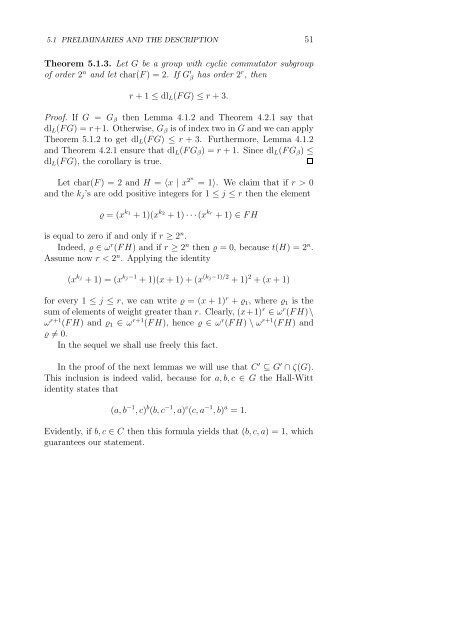On the Derived Length of Lie Solvable Group Algebras
On the Derived Length of Lie Solvable Group Algebras
On the Derived Length of Lie Solvable Group Algebras
You also want an ePaper? Increase the reach of your titles
YUMPU automatically turns print PDFs into web optimized ePapers that Google loves.
5.1 PRELIMINARIES AND THE DESCRIPTION 51<br />
Theorem 5.1.3. Let G be a group with cyclic commutator subgroup<br />
<strong>of</strong> order 2 n and let char(F ) = 2. If G ′ β has order 2r , <strong>the</strong>n<br />
r + 1 ≤ dlL(F G) ≤ r + 3.<br />
Pro<strong>of</strong>. If G = Gβ <strong>the</strong>n Lemma 4.1.2 and Theorem 4.2.1 say that<br />
dlL(F G) = r+1. O<strong>the</strong>rwise, Gβ is <strong>of</strong> index two in G and we can apply<br />
Theorem 5.1.2 to get dlL(F G) ≤ r + 3. Fur<strong>the</strong>rmore, Lemma 4.1.2<br />
and Theorem 4.2.1 ensure that dlL(F Gβ) = r + 1. Since dlL(F Gβ) ≤<br />
dlL(F G), <strong>the</strong> corollary is true.<br />
Let char(F ) = 2 and H = 〈x | x2n = 1〉. We claim that if r > 0<br />
and <strong>the</strong> kj’s are odd positive integers for 1 ≤ j ≤ r <strong>the</strong>n <strong>the</strong> element<br />
ϱ = (x k1 + 1)(x k2 + 1) · · · (x kr + 1) ∈ F H<br />
is equal to zero if and only if r ≥ 2 n .<br />
Indeed, ϱ ∈ ω r (F H) and if r ≥ 2 n <strong>the</strong>n ϱ = 0, because t(H) = 2 n .<br />
Assume now r < 2 n . Applying <strong>the</strong> identity<br />
(x kj + 1) = (x kj−1 + 1)(x + 1) + (x (kj−1)/2 + 1) 2 + (x + 1)<br />
for every 1 ≤ j ≤ r, we can write ϱ = (x + 1) r + ϱ1, where ϱ1 is <strong>the</strong><br />
sum <strong>of</strong> elements <strong>of</strong> weight greater than r. Clearly, (x+1) r ∈ ω r (F H)\<br />
ω r+1 (F H) and ϱ1 ∈ ω r+1 (F H), hence ϱ ∈ ω r (F H) \ ω r+1 (F H) and<br />
ϱ = 0.<br />
In <strong>the</strong> sequel we shall use freely this fact.<br />
In <strong>the</strong> pro<strong>of</strong> <strong>of</strong> <strong>the</strong> next lemmas we will use that C ′ ⊆ G ′ ∩ ζ(G).<br />
This inclusion is indeed valid, because for a, b, c ∈ G <strong>the</strong> Hall-Witt<br />
identity states that<br />
(a, b −1 , c) b (b, c −1 , a) c (c, a −1 , b) a = 1.<br />
Evidently, if b, c ∈ C <strong>the</strong>n this formula yields that (b, c, a) = 1, which<br />
guarantees our statement.


